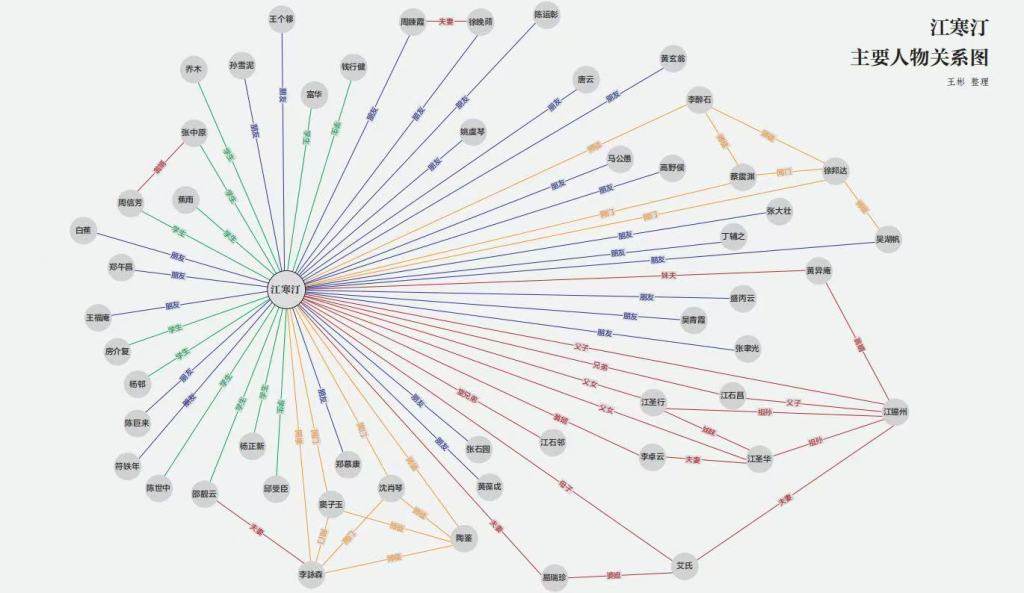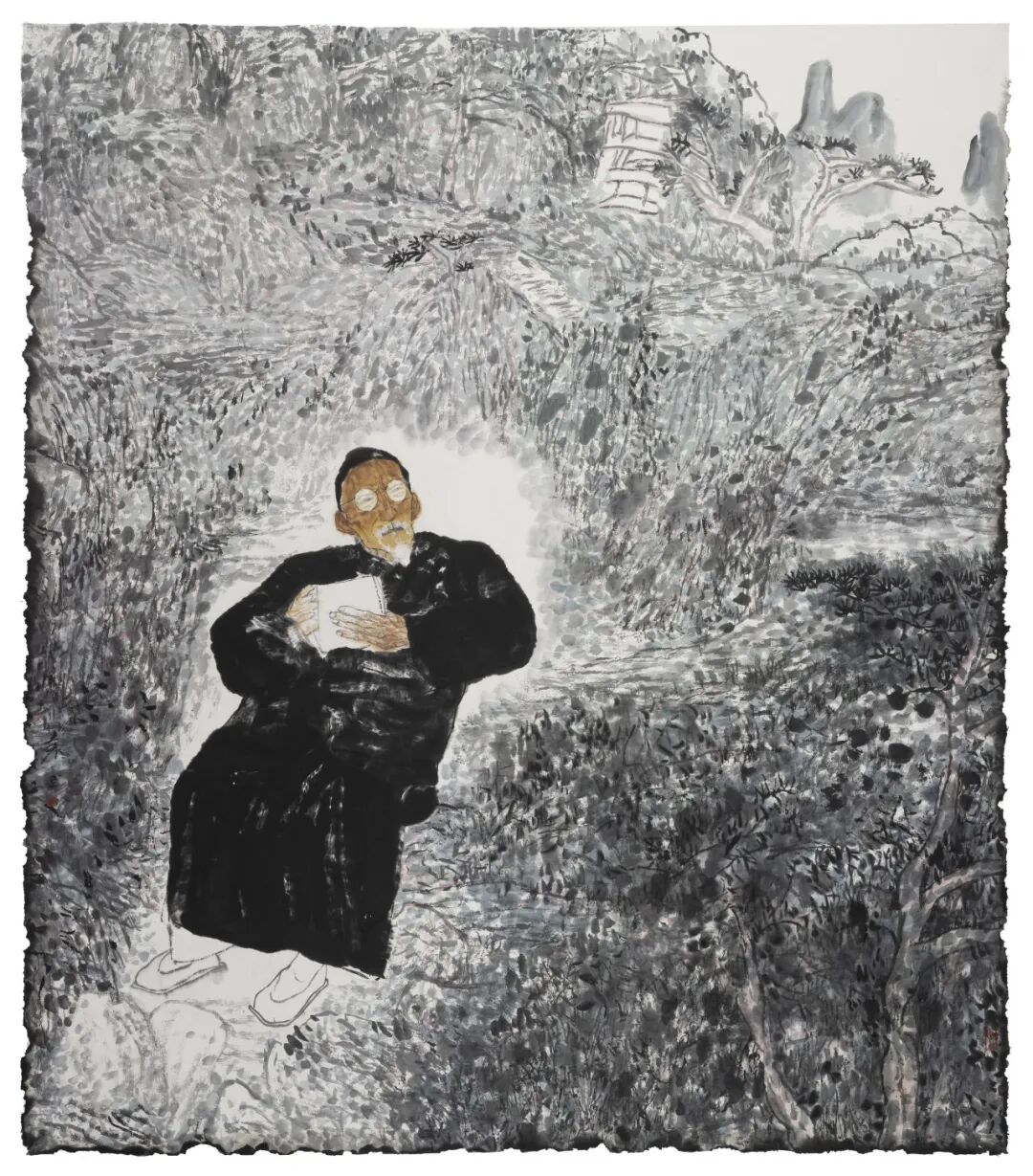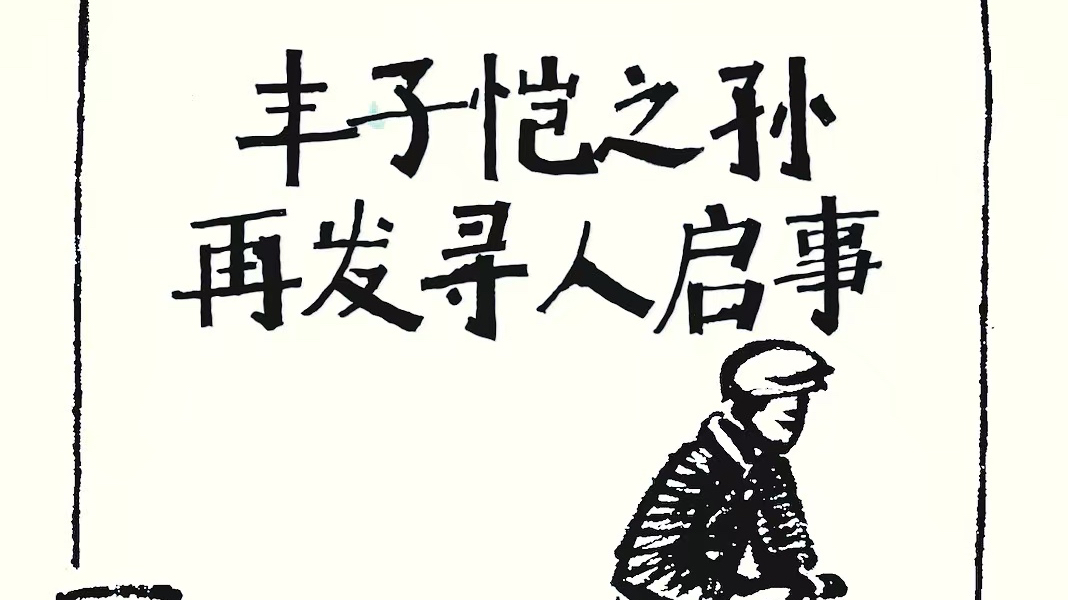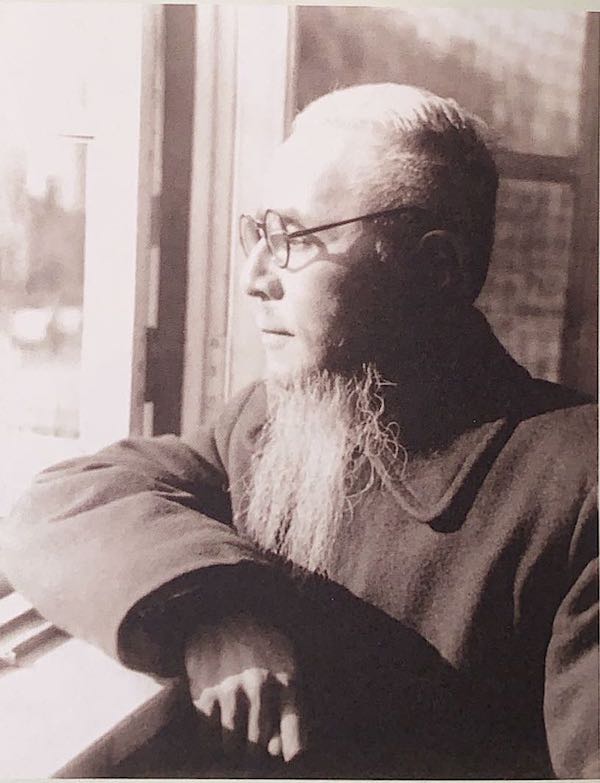
This year marks the 65th anniversary of the founding of the Shanghai Chinese Painting Academy and the 50th anniversary of the death of Mr. Feng Zikai. The "Life is Short, Art is Long - Feng Zikai Art Exhibition" co-organized by the Shanghai Chinese Painting Academy and the Feng Zikai Research Association opened on August 8 at the Shanghai Cheng Shifa Art Museum.
The Paper saw at the scene that the exhibition carefully selected nearly 200 pieces of Mr. Feng Zikai's calligraphy and painting works and important documents, divided into four sections: "Poetic Heart", "Innocent Heart", "Compassionate Heart" and "Patriotic Heart", showing the poetry, humor and philosophy of Mr. Feng Zikai's calligraphy and painting art.
Feng Zikai (1898-1975), a native of Shimen Town, Tongxiang City, Jiaxing City, Zhejiang Province, is a modern Chinese painter, essayist, art educator, music educator, cartoonist, calligrapher and translator, famous for his cartoons and essays .
The exhibition includes the last letter Feng Zikai wrote to his son Feng Xinmei, which reads: "I drink a pound of rice wine and smoke a pack of cigarettes every day." Although he was ill, he used this way to tell his son far away not to worry.

In 1963, Feng Zikai looked out from the south window of the Sun and Moon Tower.
This exhibition features a multifaceted, three-dimensional presentation of Feng Zikai's life as an artist, including his calligraphy, paintings, family letters, and his translated and published works. "I believe that Shanghai audiences, as well as those traveling from other places, will gain valuable insights and gain a more comprehensive understanding of Feng Zikai, the 'slash youth' of the Republic of China," said Feng Yu, Feng Zikai's grandson and president of the Feng Zikai Research Association.

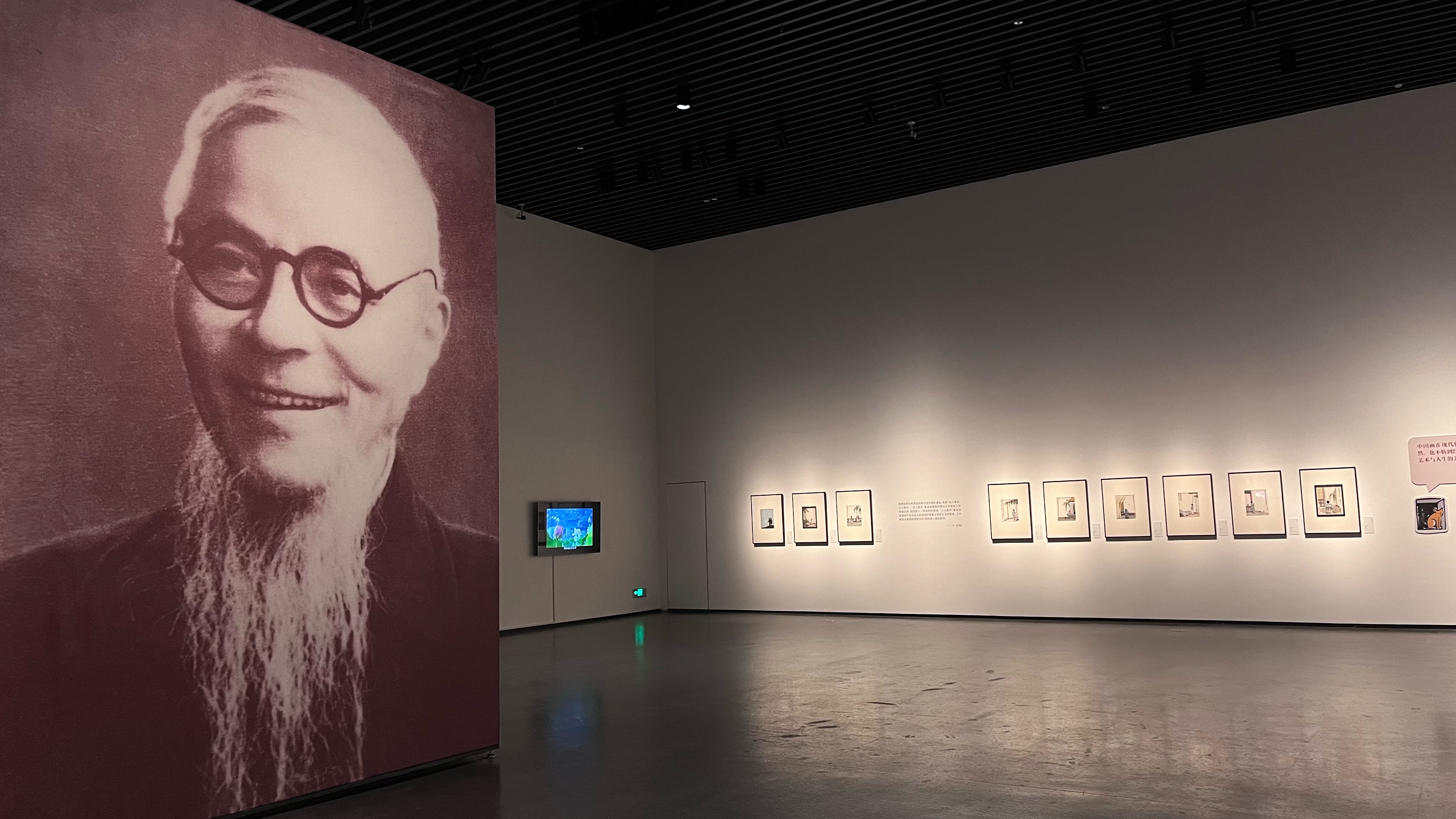
Photos and paintings of Feng Zikai at the exhibition
Feng Zikai (1898-1975) was a renowned modern Chinese painter, calligrapher, translator, essayist, and educator. A native of Shimen Town, Tongxiang, Zhejiang Province, he attended Zhejiang Provincial No. 1 Normal School, where he studied painting and music under Master Hongyi (Li Shutong) and Chinese literature under Xia Yizun. He went to Japan to study in 1921. After returning to China, he taught art and music in Shanghai, Zhejiang, Guangxi, Guizhou, and Chongqing. He is a pioneer of modern Chinese cartoons and a prominent representative of the transition from traditional to modern Chinese painting. His cartoons are a reflection of Chinese freehand brushwork, depicting everyday life in simple ink and brushstrokes. He developed a unique style characterized by a simple and timeless quality, imbued with poetry, humor, and philosophical insight, making him a unique figure in the history of modern Chinese painting. He was also the founding president of the Shanghai Chinese Painting Academy and served as chairman of the Shanghai branch of the China Artists Association.
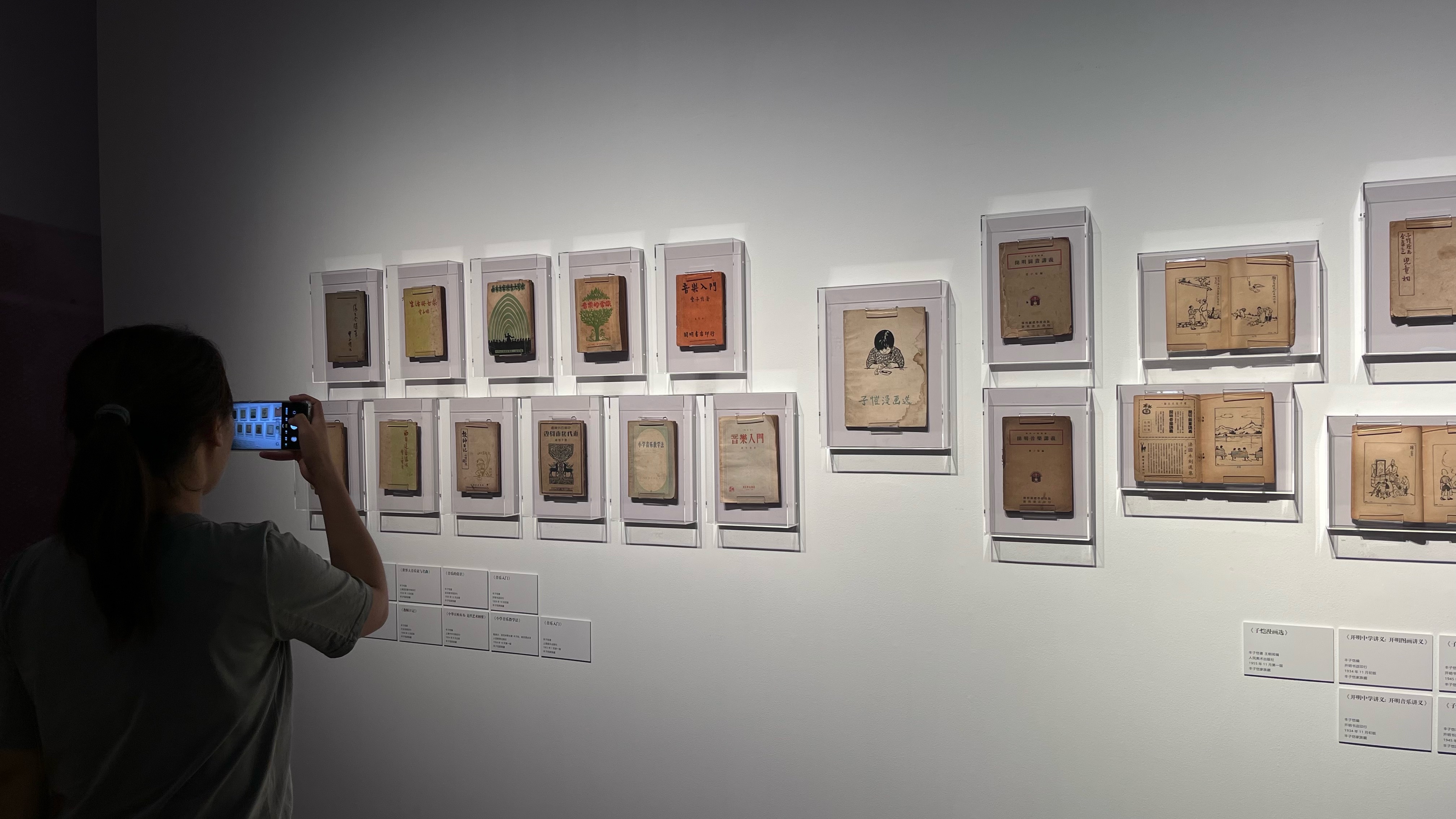
Exhibition site, related books and publications
Come to the world of mortals and sing the joys and sorrows of life
Feng Zikai once said, "Why should modern Chinese painting simply hide in the mountains to praise nature? Why not come out into the mortal world and sing the joys and sorrows of life, thus deepening the connection between art and life? Wouldn't that be better?" He also put this into practice. He believed that his paintings were neither imitating the brushwork of Bada Shanren nor based on the theories of Cubism or Flat Design. "They are simply recording my daily feelings with a writing brush, like keeping an account."
In his view, the idea of painting comes before the brush. "As long as the idea is there, the brush doesn't have to be there. Not only can it not be there, but sometimes it can even be a burden." Drawing comics with a brush is more akin to calligraphy, pursuing a concise and smooth line rather than the complexities of traditional fine brushwork or the heaviness of Western oil painting.
The small paintings in the exhibition depict the various aspects of human life, joy, anger, sorrow and happiness. The inspiration for his creations comes from what he sees and hears in daily life, the momentary touches and instantaneous insights.
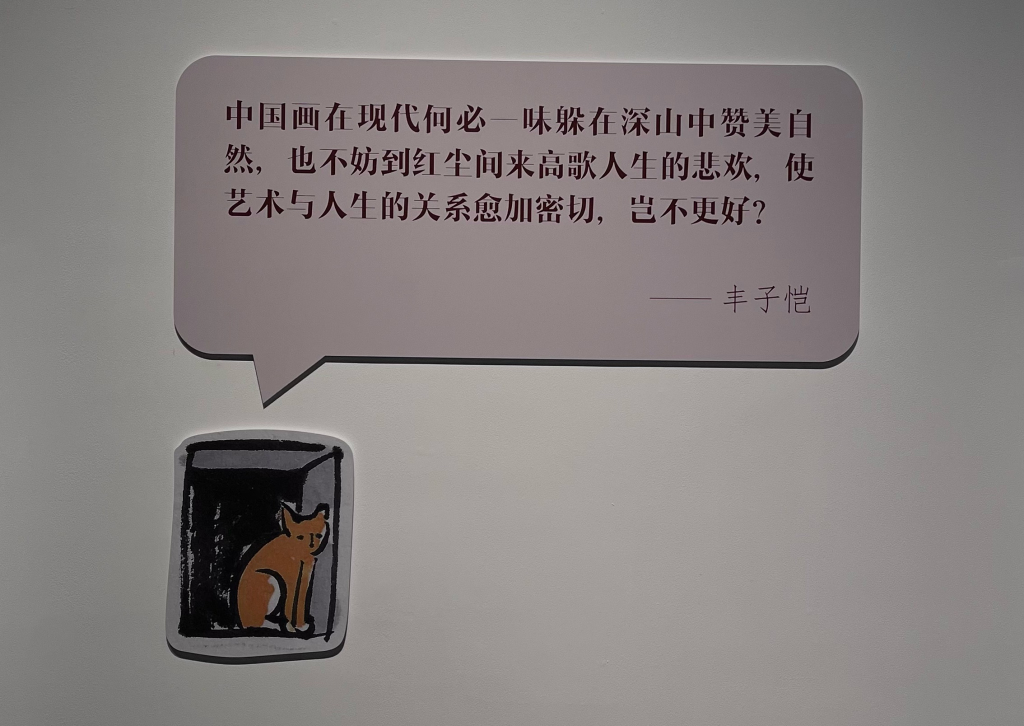
Feng Zikai's quotations displayed in the exhibition hall
In his essay "Painting and Literature," Feng Zikai argued that of all arts, literature is the most accessible to the masses. This is because literature uses language, something everyone uses daily, requiring no new learning; the basics are readily available. Few people understand so-called "pure painting," which expresses itself purely through form and color; however, a wider audience understands so-called "literary painting," which blends form and color with literary meaning.
"So, for the sake of popular art, infusing art with literary flavor is also a method that benefits the general public."
The words written in the corner of the small painting become an embellishment of the painting and also a key to literature. While recording the trivialities of the family, it also allows the scenes of life to become a mirror reflecting the times.

Mom is Busy with Her Knife and Ruler

The Balance of Love

Fallen Petals Are Not Heartless

High Counter
In addition to calligraphy and paintings, the exhibition also features several family letters and original envelopes worth exploring. Feng Yu, Feng Zikai's grandson (son of Feng Xinmei) and president of the Feng Zikai Research Association, highlighted two particularly valuable family letters to The Paper (www.thepaper.cn).
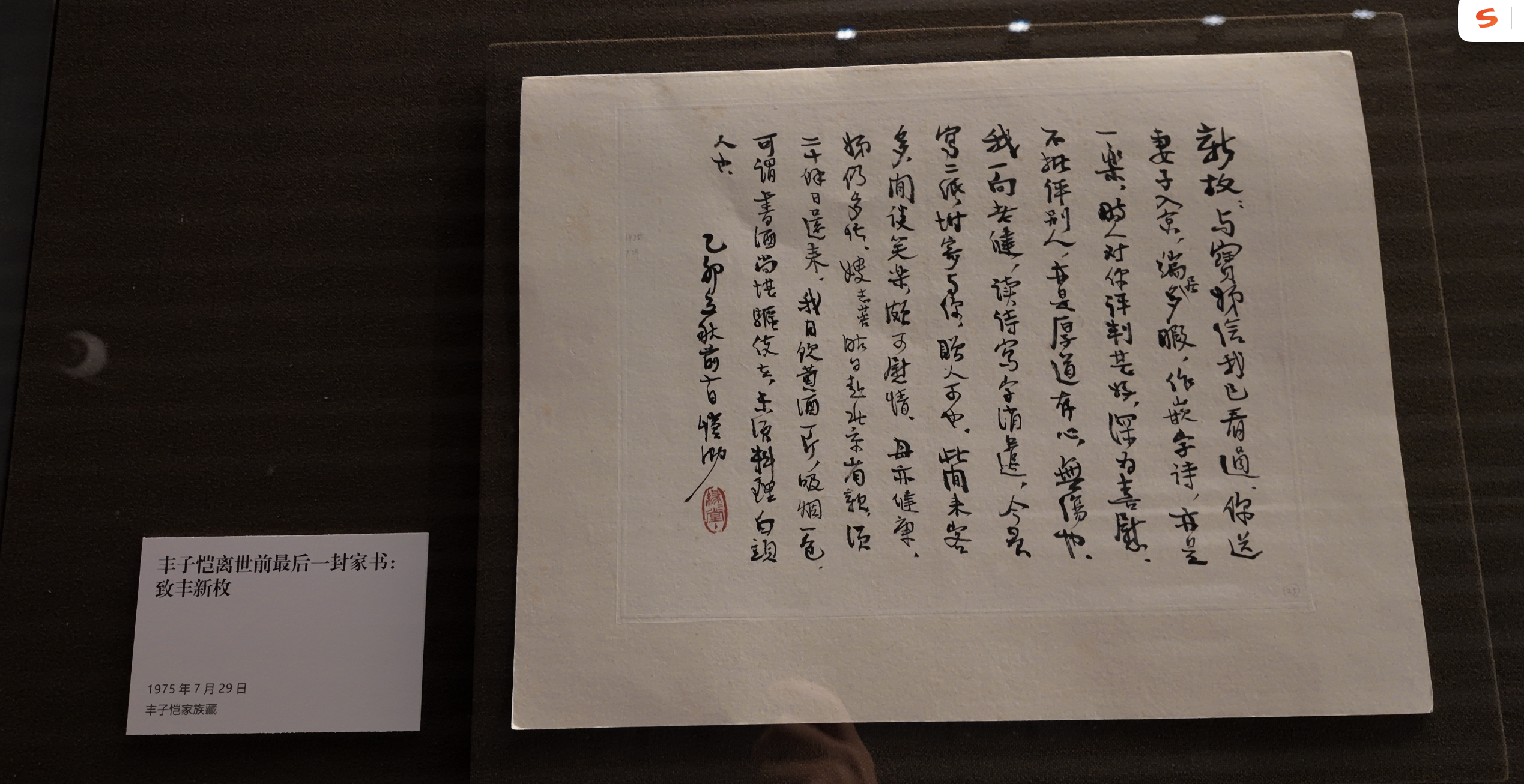
Feng Zikai's last letter to his family before his death, 1975.
The letter on display is Feng Zikai's last before his death, written to his son Feng Xinmei on July 29, 1975. Feng Yu explained to The Paper (www.thepaper.cn), "He was admitted to the hospital around the 30th, and passed away on September 15th." He hopes everyone will pay attention to the last two lines Feng Zikai wrote to his son: "I drink a pound of rice wine and a pack of cigarettes a day." He eats and drinks as needed, and his body is not weak. "He was telling my father not to worry, that he is in good health, can eat and smoke," and he was using this way to update his distant son on his latest condition. "Of course, when my father received this letter, he also received a telegram saying he had been admitted to the hospital, so he rushed to Shanghai."
The letter was written on rice paper using a traditional Chinese brush, from top to bottom and from right to left. It was also stamped with a seal. "I think it somehow represents that he, as a cultural person, ended his calligraphy and painting career in a traditional Chinese way."
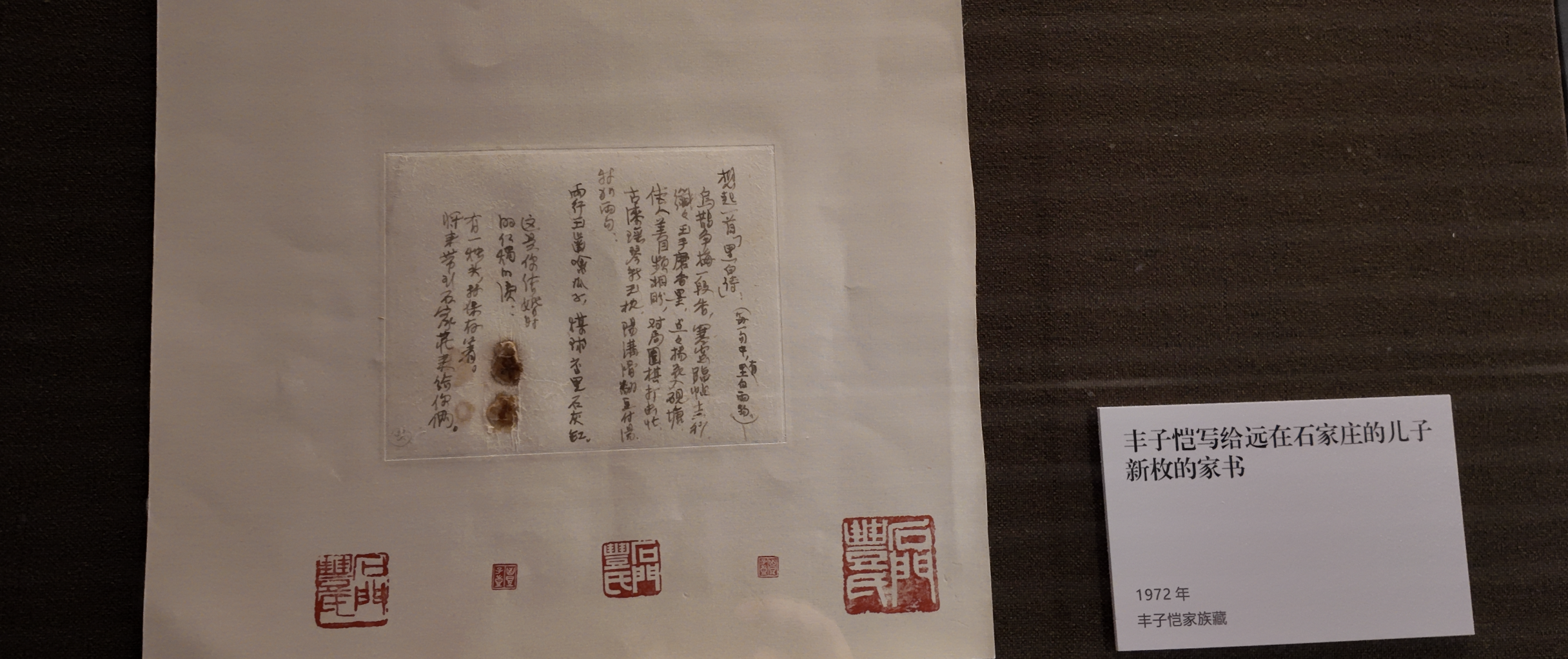
A letter from Feng Zikai to his son Xinmei in Shijiazhuang, 1972.
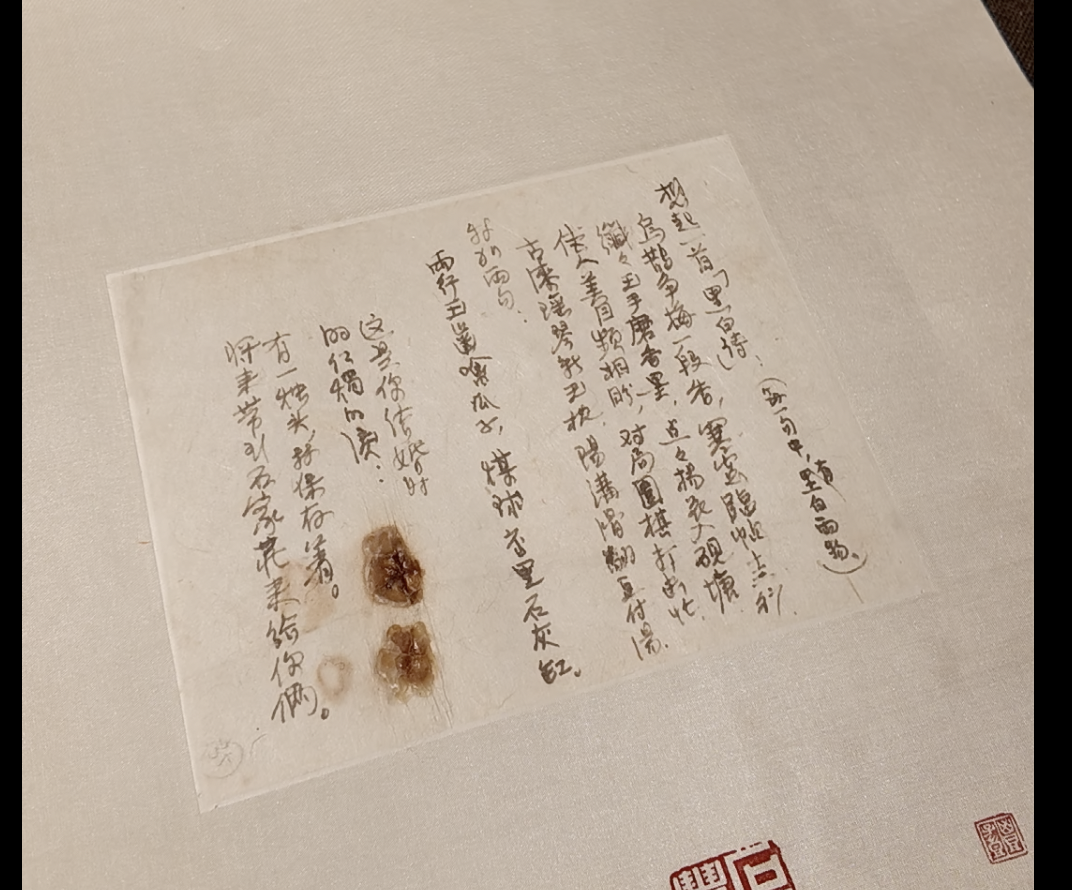
The letter written by Feng Zikai to Feng Xinmei, congratulating her on her wedding, has two drops of "red candle tears" on it.
This letter, written by Feng Zikai to Feng Xinmei, is also very meaningful. "The year my father got married, Feng Zikai, as a father, specially kept the pair of red candles used in the wedding and dripped a drop of candle wax onto each, naming them 'Red Candle Tears.'" He also included a poem in black and white, a poem by an ancient poet. It depicts a heartwarming scene, written by a Qing Dynasty scholar while enjoying the snow with his wife, children, and servants during the Lantern Festival. Every sentence contains both black and white. For example, the first line, "Crows and sparrows compete for the fragrance of plum blossoms," is black, and the plum blossoms are white. "Copying thirteen lines by the cold window," involves brush, ink, and paper, both black and white. "Slender jade hands grind fragrant ink," is white, and the ink is black. "Sprinkles of willow catkins fall into the inkstone pond," is naturally white, and the inkstone pond is naturally black. "The beautiful woman's eyes gazed at me frequently," and "the game of Go was busy." "Ancient lacquered jade zither and new jade pillow," and "The gutter spilled tofu soup." Every sentence contains imagery of black and white. "He wrote this poem for my father, along with some red candle tears, to remind them of this romantic moment of their marriage. I believe few people can write letters these days, and stamps might not even be sold anymore, but back then, everyone relied on them to communicate."

Feng Yu's letter of introduction. Photo by Liang Jia, a reporter from The Paper.

Feng Zikai wrote a series of poems

Envelopes on display
"Forty years ago, ordinary people communicated mainly through letters. These envelopes reveal Feng Zikai as a man of culture. He designed them himself and had them printed, hence the red inscription on the envelopes: 39 South Shaanxi Road, Shanghai. These were addressed to my father, who attended Tianjin University, and were all written with a brush. So the envelopes themselves are meaningful; they are a cultural memory and a trace of the times."
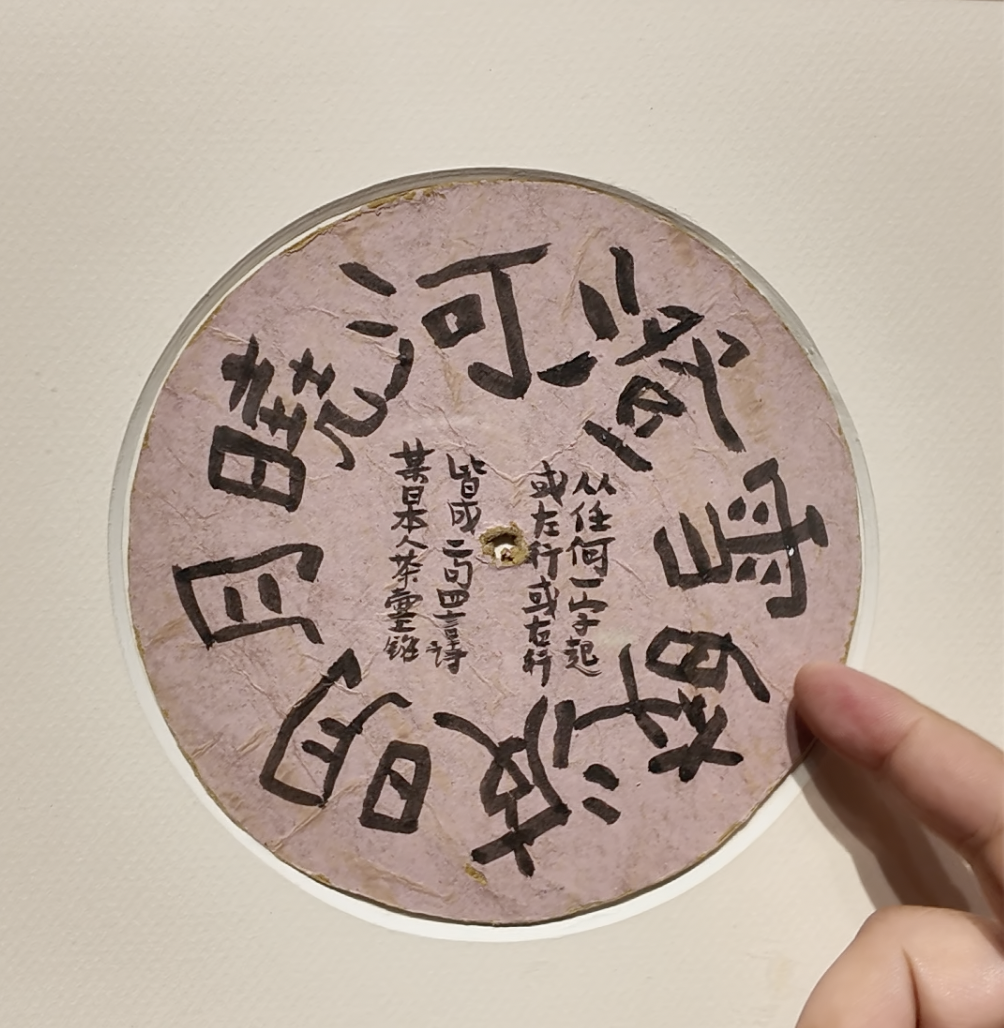
Feng Yu introduced that the eight characters on this disc can be turned into a poem by reading any one of them.
"He bought a teapot from Japan with eight characters on it. He translated them into Chinese and made a turntable with a needle in the middle. He would stop at any character and read it clockwise or counterclockwise. It would become a four-character poem, eight characters in total."
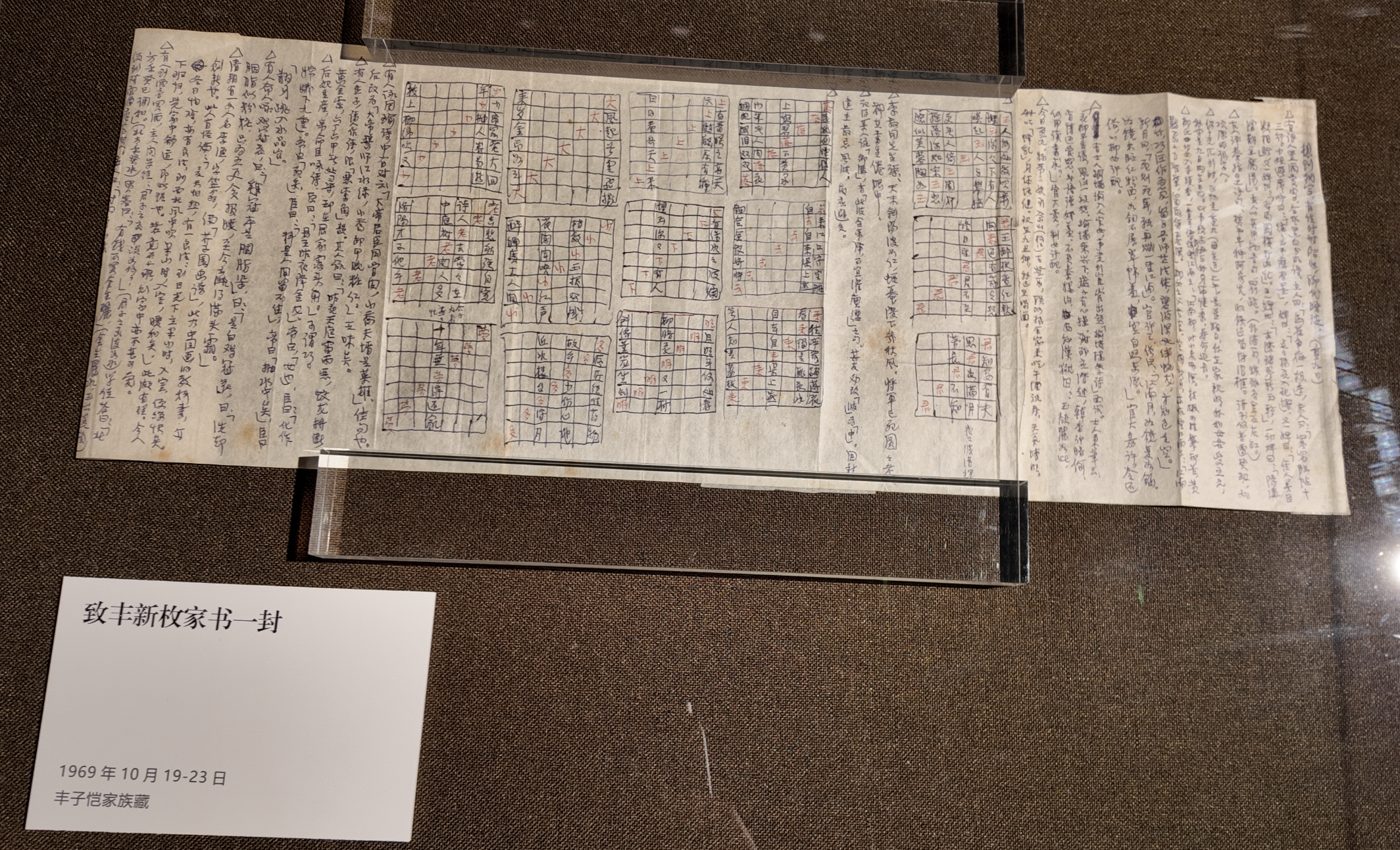
A family letter to Feng Xinmei, written between October 19 and 23, 1969.
Feng Zikai wrote a letter home in October 1969, which included a crossword puzzle that could be connected to form a short poem. The little details of daily life become a warm and interesting experience.
Each cartoon is like a short poem
"Mr. Feng Zikai is not only the pioneer of modern Chinese cartoons, but also an outstanding representative of the transformation of Chinese painting from tradition to modernity. He inherited the freehand tradition and poetic core of Chinese painting, expressing daily trivialities in the form of simple ink and wash, paying attention to incorporating calligraphy into painting, emphasizing the presence of poetry in painting, and pursuing the meaning beyond the painting and the charm beyond the rhyme. His works are concise, bright, plain and meaningful, unique in the history of modern Chinese painting and forming a school of his own." said Ms. Yi E, curator, director of the research department of the National Art Museum of China and research curator.
Because he studied under Master Hongyi, Feng Zikai's writing is both accessible and thought-provoking. In 1927, he published an article in the Eastern Magazine titled "The Characteristics of Chinese Painting: Poetry in Painting," attributing the uniqueness of Chinese painting to its poetic quality: "To transform into a butterfly, to wander the Moon Palace—these are things that humans only dream of, yet can achieve in dreams. Chinese painting, in fact, is a true reflection of the Chinese people's dreams."
At the same time, he also believed that paintings of pure artistic interest were suitable for specialists, while paintings infused with literary meaning were more palatable to the general public. He used an analogy: pure painting and pure music are like white bread, while paintings and music infused with literary meaning are like grape bread. Chewing white bread carefully reveals a profound flavor, but this taste can only be appreciated by a first-rate taster like Yi Ya. Grape bread, on the other hand, is delicious and enjoyable to the average person.
Zhu Ziqing once said Feng Zikai's cartoons are poetic, each one like a short poem—a poem with a core. "You reveal the world of poetry, bit by bit, and we are like eating olives, always tasting the flavor."

Calligraphy scroll. Feng Zikai's "Nineteen Ancient Poems" written with a brush (detail)

"Nineteen Ancient Poems" written by Feng Zikai with a brush (partial) "Bodhisattva Man" by Wen Tingyun.

Feng Yu introduced that he stamped the seals at the end of the volume one by one.
The exhibition features a long calligraphy scroll worth examining. Feng Yu explained that he added the seals at the end of the scroll one by one, many of which are from renowned masters. Seeing the discreet arrangement of seals, large and small, within this particular space is quite captivating.
"He was essentially a sentimental poet. Poetry was both the source of his creations and the essence of his art," said curator Yi'e. Feng Zikai adored classical poetry, reciting numerous verses throughout his life. "He also taught his children daily recitation of classical poetry. He would copy down his favorite classical poems in calligraphy and translate them into his paintings, poetry into painting – a hallmark of his art. Some of his creations are known as "New Paintings of Classical Poetry," translating the artistic conception of classical poetry into a modern painting. Therefore, his artworks are enduring and always fresh to the eye because of their rich poetic quality, which is inseparable from his profound understanding of classical poetry." Feng Zikai, a self-proclaimed admirer of children, had seven children whom he particularly loved and often used as subjects in his paintings. "With his passionate brush, he celebrated the purity and innocence of children and criticized the filth and hypocrisy of the adult world. Truth was both his way of life and the principle of his art."

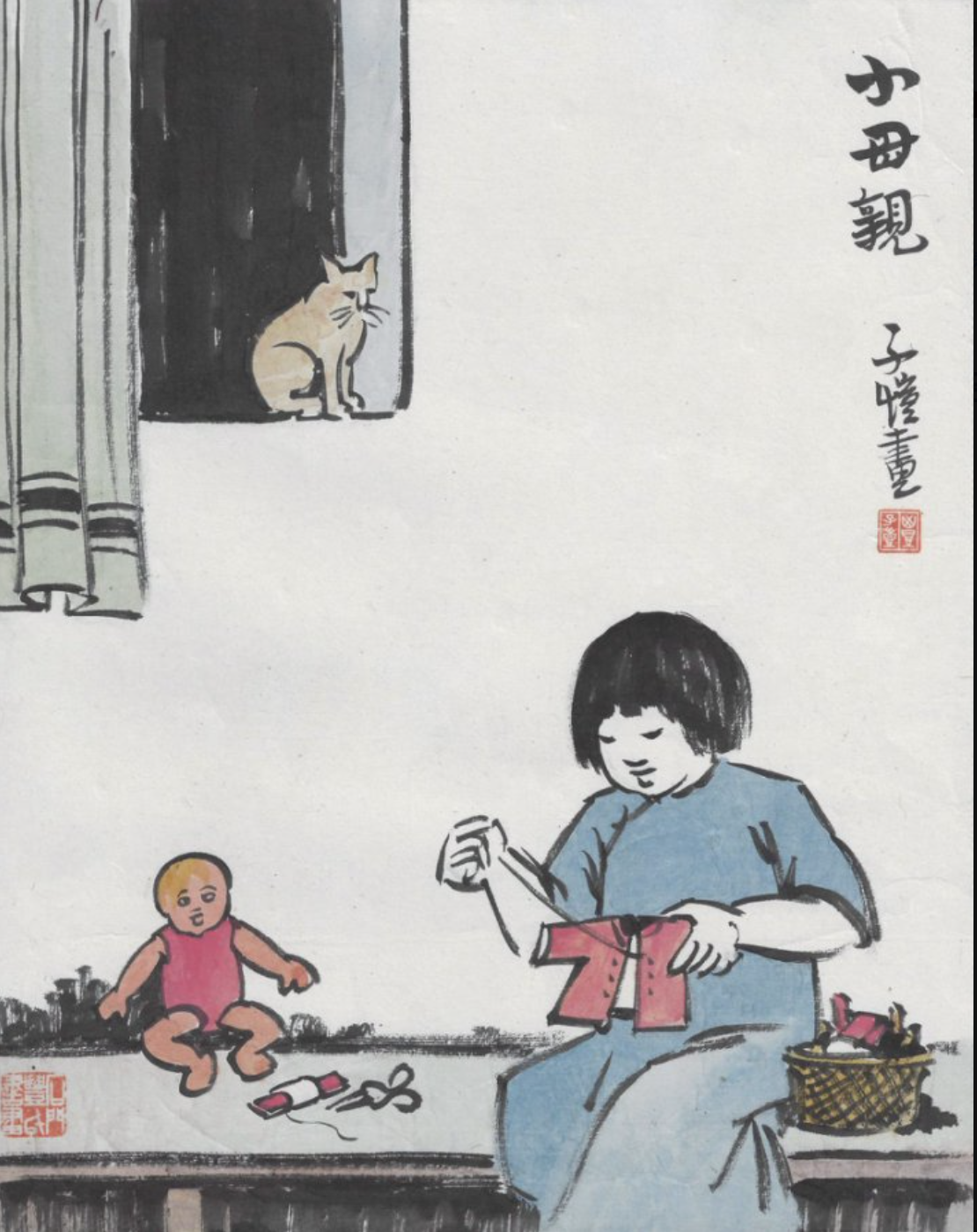
Little Mother, 30cm×23cm, Undated, Collection of Feng Zikai's Family

Sisters, 30cm×23cm, no date, Feng Zikai family collection
In works such as "Little Mother," he passionately praises the purity and innocence of children while simultaneously criticizing the filth and hypocrisy of the adult world. In his view, "the most sound minds and eyes in the world belong only to children, and only children can see the truth of the world most clearly and completely."
Mr. Feng Zikai has a compassionate heart. He once created "A Collection of Pictures on Protecting Life", urging people to cherish life, stop killing, cultivate kindness, and advocate peace. Love is both the background color of his life and the keynote of his art.
Feng Zikai believed that human life can be divided into three levels: material life, spiritual life, and soul life. Material life is food and clothing. Spiritual life is academics and literature. Soul life is religion.
Feng Zikai's "Collection of Pictures for the Protection of Life" is a masterpiece that embodies the fusion of modern Chinese art history and Buddhist culture. Spanning 46 years, it comprises six volumes and 450 works. In 1927, to celebrate his mentor's 50th birthday, Feng Zikai vowed to create paintings dedicated to the theme of abstaining from killing and protecting life. Master Hongyi proposed the concept of "a collection every ten years, with the number of paintings increasing as my age grows," meaning he would create 50 paintings at 50, 60 at 60, and so on until he reached 100. Ma Yifu, in his preface to the first collection, expounded: "Eliminate cruelty, cultivate compassion, and then use this heart to treat others and the world." While the collection ostensibly advocates the protection of life, it actually seeks to awaken the benevolence and compassion in human nature, transcending the confines of religious instruction to become a universal medium for humanistic education.

The Net

The Wailing
This childlike innocence is particularly moving in the essay "Recalling Childhood." Feng Zikai fondly recalls three childhood memories: raising silkworms in memory of his grandmother, eating crabs with his father during the Mid-Autumn Festival, and fishing with his friend Wang Nannan. However, the essay ends with a surprising twist: "My golden age was short, and these are the only three things I cherish. Unfortunately, they all involved killing for pleasure, and they fill me with eternal remorse." This profound understanding of the equality of life and his sense of remorse demonstrate the moral height of his artistic spirit.
Feng Zikai's preference for children's themes is not only an aesthetic choice, but also an attitude towards life - treating everything in the world with childlike sincerity.
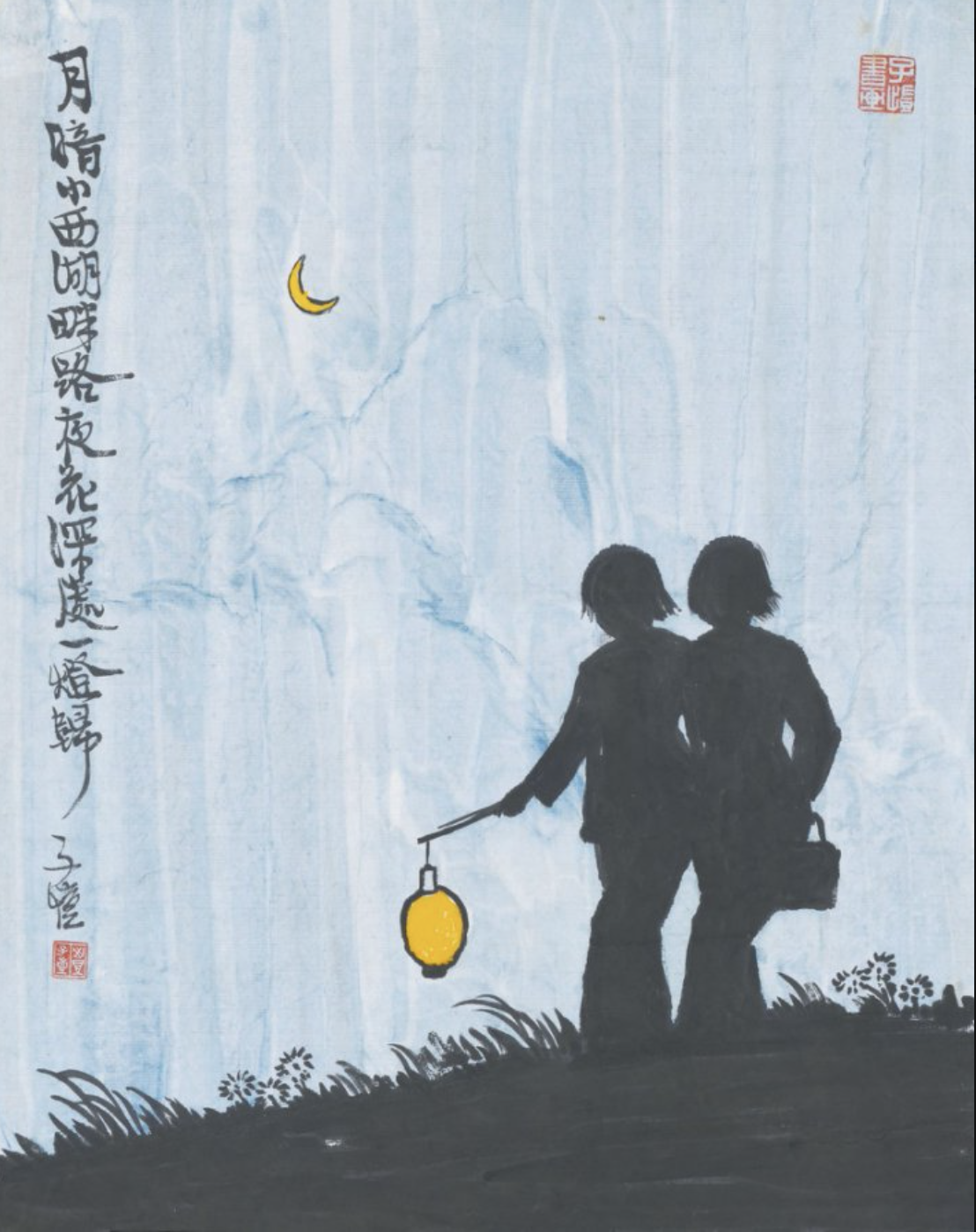
A Light Returns in the Depths of Night Flowers, 35cm×28.5cm, Collection of Cui Dongming, 1971
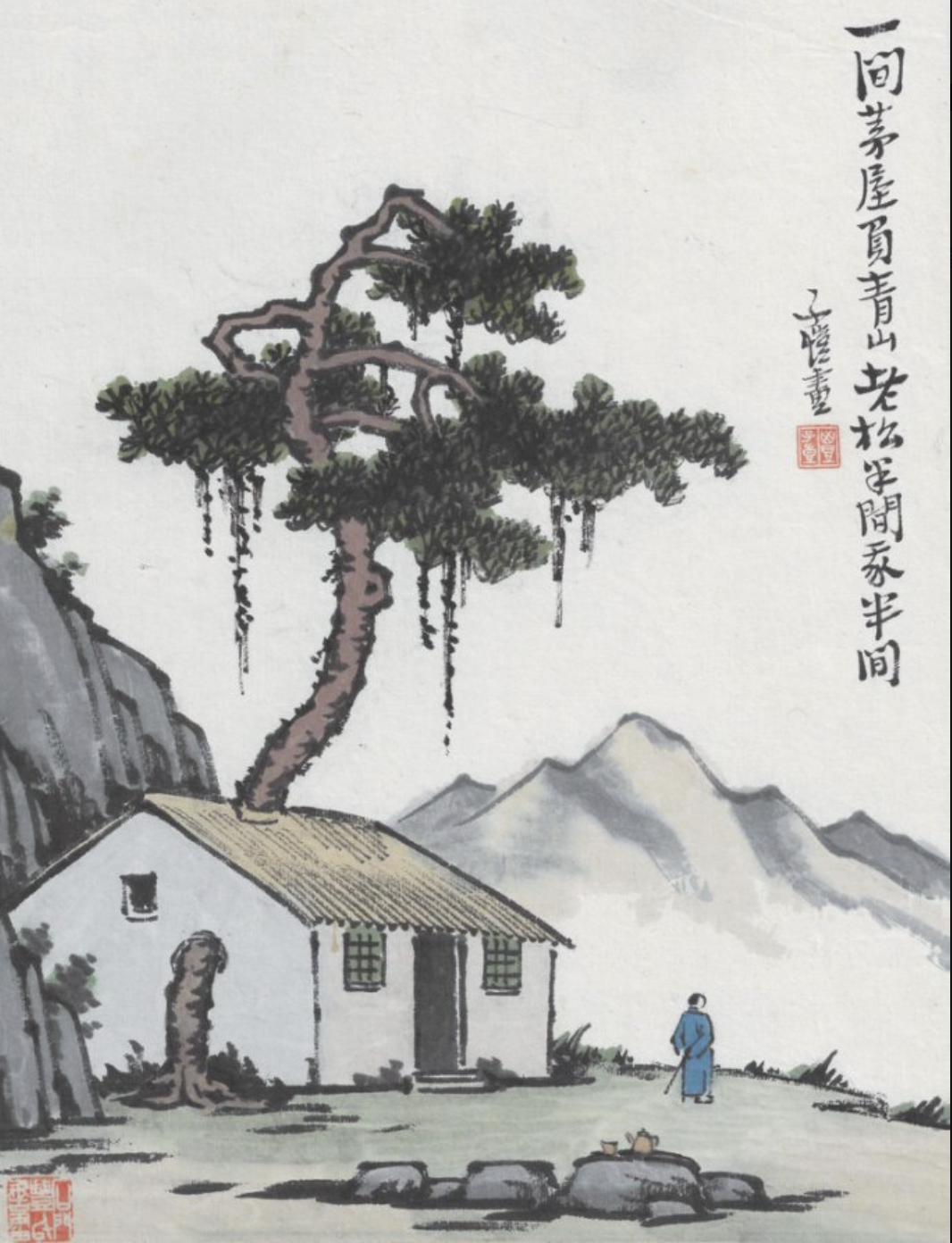
A Thatched Hut Facing Green Mountains, Ink and color on paper, 30cm×23cm, Undated, Collection of Feng Zikai's Family

Curator Yi'e introduces the exhibits. Photo by Liang Jia, a reporter from The Paper.
Regardless of era, Feng Zikai's works embody a poetic spirit, a childlike heart, a compassionate heart, and a patriotic heart. These four hearts, from different perspectives, interpret the four characteristics of all of Feng Zikai's works: moderation, balance, and harmony. "Moderation refers to Chinese style, tradition, and Chinese characteristics; righteousness refers to positivity, justice, integrity, and positive energy; balance refers to simplicity, tranquility, peace, and approachability; and harmony refers to integration, conjunction, and unity, combining Eastern and Western art, blending morality and interest, and integrating the refined with the common. I believe this feeling, through the hundreds of works on display today, will leave viewers with a lasting impression," said curator Yi E.
When the brush and ink lose their embellishments, the calmness, tranquility and compassion that emanate from within have the tremendous power to penetrate time and space and reach people's hearts.

During the Spring Festival of 1963, Feng Zikai and "Ami" were in the Sun and Moon Building.
A Western proverb says, "Life is short, art is long." Although he only spent a short 78 years on earth, the great love and true feelings expressed in his art will last forever.
Jiang Peng, Party Secretary and Vice President of the Shanghai Chinese Painting Academy, said, "Mr. Feng Zikai's works come from the people and give back to the people, while also gaining recognition from the people and being deeply loved by the general public. This reflects Mr. Feng Zikai's infinite love for nature and ordinary life, and also demonstrates that art comes from life and is rooted in life. It is a model for the popularization and integration of art into everyday life."

Jiang Peng, Party Secretary and Vice President of the Shanghai Chinese Painting Academy. Photo by Liang Jia, The Paper
The exhibition will run until September 7th.
It is also reported that on the evening of August 8, the opening day of the exhibition, Cheng Shifa Art Museum will extend its opening hours to 21:00 (no admission at 20:00), and invite Mr. Feng Yu, President of the Feng Zikai Research Association and grandson of Feng Zikai, to give a lecture entitled "Art on the Sea - Feng Zikai's Artistic Life in Shanghai", to trace Feng Zikai's footprints in Shanghai with the audience and deeply appreciate Mr. Feng Zikai's unique artistic charm.

Cherry color stamp

Cultural creations and books at the exhibition
- pMMSsSaG08/09/2025
- ILPVWUpRnNw08/09/2025
